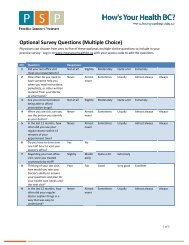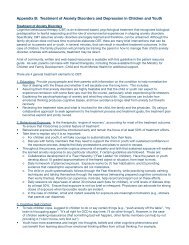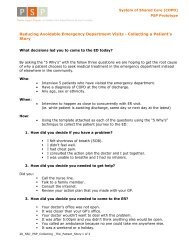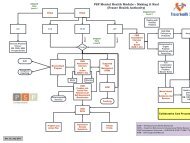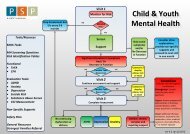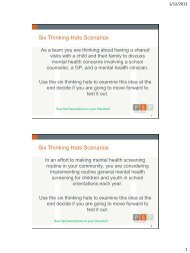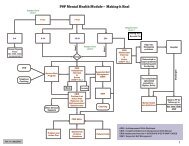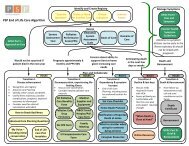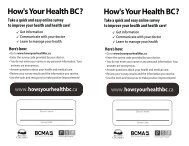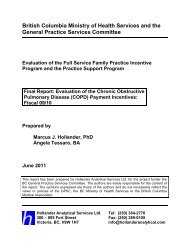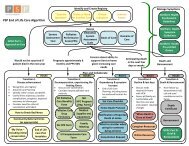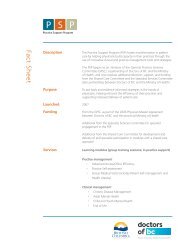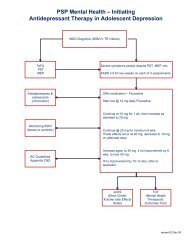Anxiety Addendum - GPSC
Anxiety Addendum - GPSC
Anxiety Addendum - GPSC
You also want an ePaper? Increase the reach of your titles
YUMPU automatically turns print PDFs into web optimized ePapers that Google loves.
CBIS<br />
Cognitive Behavioural Interpersonal Skills<br />
.............................<br />
<strong>Anxiety</strong> <strong>Addendum</strong>
Table of Contents<br />
FLOW CHARTS .................................................................................................. 76<br />
EDUCATION MODULE ...................................................................................... 79<br />
The Many Faces of <strong>Anxiety</strong> ............................................................................. 80<br />
Notes to Practitioner ........................................................................................ 81<br />
Medical Considerations ................................................................................... 82<br />
Understanding Generalized <strong>Anxiety</strong> Frequently Asked Questions .................. 83<br />
<strong>Anxiety</strong> “System-Wide Explosion” ................................................................... 84<br />
Considering Medication for <strong>Anxiety</strong> Disorders? ............................................... 85<br />
Resources for Self-Help .................................................................................. 86<br />
COGNITIVE BEHAVIORAL MODULE ................................................................ 87<br />
GAD: Self-Assessment Questionnaire ............................................................ 88<br />
GAD: Self-Assessment Profile......................................................................... 89<br />
Costs and Benefits of <strong>Anxiety</strong>.......................................................................... 91<br />
How <strong>Anxiety</strong> Works ......................................................................................... 92<br />
Panic Circle ..................................................................................................... 94<br />
Taking Control of Panic ................................................................................... 95<br />
Your Emotional Thermometer ......................................................................... 96<br />
Keeping <strong>Anxiety</strong> in Check ............................................................................... 97<br />
<strong>Anxiety</strong> Equation ............................................................................................. 98<br />
Predicting Disaster .......................................................................................... 99<br />
<strong>Anxiety</strong> Lies ................................................................................................... 101<br />
Coping Cards ................................................................................................ 102<br />
Coping Plans ................................................................................................. 103<br />
Problem Solving ............................................................................................ 104<br />
Taking Risks .................................................................................................. 105<br />
Assertive Behaviour 101 ............................................................................... 107<br />
D.E.S.C. Script .............................................................................................. 108<br />
Patient Empowerment <strong>Anxiety</strong> Manual VIHA March.2010 i
FLOW CHARTS<br />
………………………………………..<br />
This module contains flow charts that direct you<br />
to the appropriate CBT strategies in this manual.<br />
When in doubt – go with the flow.<br />
Patient Empowerment <strong>Anxiety</strong> Manual VIHA March.2010 76
Self-Management &CBT Strategies<br />
GENERALIZED<br />
ANXIETY DISORDER<br />
Self-Assessment Questionnaire, pg 88<br />
Self-Assessment Profiles, pg 89<br />
Understanding Generalized <strong>Anxiety</strong>, pg 83<br />
<strong>Anxiety</strong> “System-Wide Explosion”, pg 84<br />
Abdominal Breathing, pg 60<br />
Passive Relaxation, pg 64<br />
Mindfulness, pg 67<br />
Costs and Benefits of <strong>Anxiety</strong>, pg 91<br />
How <strong>Anxiety</strong> Works, pg 92<br />
Common Thinking Errors, pg 47<br />
Your Emotional Thermometer, pg 96<br />
Thought Stopping, pg 51<br />
Worry Time, pg 52<br />
<strong>Anxiety</strong> Equation, pg 98<br />
Predicting Disaster, pg 99<br />
<strong>Anxiety</strong> Lies, pg 101<br />
Coping Cards , pg 102<br />
Coping Plans, pg 103<br />
Problem Solving, pg 105<br />
Taking Risks, pg 106<br />
Self Talk/Mean Talk, pg 50<br />
Good Guilt/Bad Guilt, pg 53<br />
Setting Limits, pg 55<br />
Is Anger A Problem For You?, pg 57<br />
SOCIAL<br />
ANXIETY DISORDER<br />
<strong>Anxiety</strong> “System-Wide Explosion”, pg 84<br />
Abdominal Breathing, pg 60<br />
Grounding, pg 62<br />
Body Scan, pg 63<br />
Costs and Benefits of <strong>Anxiety</strong>, pg 91<br />
How <strong>Anxiety</strong> Works, pg 92<br />
<strong>Anxiety</strong> Equation, pg 98<br />
Taking Risks, pg 105<br />
Self Talk/Mean Talk, pg 50<br />
Assertive Skills, pg 54<br />
Assertive Behavior, pg 107<br />
Setting Limits, pg 55<br />
Patient Empowerment <strong>Anxiety</strong> Manual VIHA.March.2010 77
PANIC DISORDER<br />
<strong>Anxiety</strong> “System-Wide Explosion”, pg 84<br />
Abdominal Breathing, pg 60<br />
Grounding, pg 62<br />
How <strong>Anxiety</strong> Works, pg 92<br />
Panic Circle, pg 94<br />
Taking Control of Panic, pg 95<br />
<strong>Anxiety</strong> Equation, pg 98<br />
Predicting Disaster, pg 99<br />
Coping Cards, pg 103<br />
Taking Risks, pg 105<br />
PHOBIA<br />
<strong>Anxiety</strong> “System-Wide Explosion”, pg 84<br />
Abdominal Breathing, pg 60<br />
Grounding, pg 62<br />
Body Scan, pg 63<br />
Taking Control of Panic, pg 95<br />
<strong>Anxiety</strong> Equation, pg 98<br />
Coping Cards, pg 102<br />
Taking Risks, pg 105<br />
PTSD<br />
<strong>Anxiety</strong> “System-Wide Explosion”, pg 84<br />
Abdominal Breathing, pg 60<br />
Grounding, pg 62<br />
How <strong>Anxiety</strong> Works, pg 92<br />
Panic Circle, pg 94<br />
Taking Control of Panic, pg 95<br />
Coping Cards, pg 102<br />
Taking Risks, pg 105<br />
OCD<br />
<strong>Anxiety</strong> “System-Wide Explosion”, pg 84<br />
Stress Busters, pg 65<br />
Meditation, pg 68<br />
One Minute Stress Break, pg 66<br />
Costs and Benefits of <strong>Anxiety</strong>, pg 91<br />
How <strong>Anxiety</strong> Works, pg 92<br />
Common Thinking Errors, pg 47<br />
Keeping <strong>Anxiety</strong> in Check, pg 97<br />
Thought Stopping, pg 48<br />
<strong>Anxiety</strong> Equation, pg 98<br />
Coping Cards, pg 102<br />
Problem Solving, pg 104<br />
Taking Risks, pg 105<br />
Patient Empowerment <strong>Anxiety</strong> Manual VIHA.March.2010 78
EDUCATION MODULE<br />
………………………………………..<br />
The education module contains handouts<br />
providing basic information on anxiety for<br />
practitioners, patients and their families<br />
It includes a handout for patients who may be<br />
considering medication as well as a list of<br />
websites and self-help materials<br />
Choose the handouts that correspond to patient<br />
needs<br />
Patient Empowerment <strong>Anxiety</strong> Manual VIHA March.2010 79
The Many Faces of <strong>Anxiety</strong><br />
Panic Disorder with or without agoraphobia<br />
Recurrent unexpected panic attacks without an obvious trigger<br />
Avoidance of situations where panic attacks have occurred<br />
(agoraphobia)<br />
Example: A person may have bouts of intense fear and avoid leaving<br />
the house alone<br />
Social <strong>Anxiety</strong> Disorder<br />
Excessive or unrealistic fear of social situations or performance<br />
Intolerance of embarrassment or scrutiny by others<br />
Example: A person is so shy that they cannot speak in a group<br />
Obsessive Compulsive Disorder<br />
Presence of obsessions (intrusive thoughts, images, or urges that<br />
cause anxiety)<br />
Presence of compulsions (repetitive behaviours or mental acts that are<br />
performed to reduce anxiety)<br />
Example: A person washes their hands repetitively until they are raw<br />
because they are afraid of germs<br />
Specific Phobia<br />
Unreasonable fear of a specific object or situation usually associated<br />
with avoidance<br />
Example: A person is so afraid of flying that they cannot travel by plane<br />
Generalized <strong>Anxiety</strong> Disorder<br />
Uncontrollable and excessive worry occurring most days about ordinary<br />
activities<br />
Intolerance of uncertainty<br />
Example: A person worries a lot about harm coming to their family<br />
members on a routine trip to town<br />
Post Traumatic Stress Disorder<br />
Occurs after a traumatic event to which the patient responds with<br />
intense fear, helplessness, or horror<br />
Patients relive the event in memories or dreams; avoid reminders of the<br />
event and experience symptoms of increased vigilance<br />
Example: A person returns from war and relives the battlefield traumas<br />
in his nightmares and startles at the sound of loud noises<br />
Patient Empowerment <strong>Anxiety</strong> Manual VIHA.March.2010 80
Notes to Practitioner<br />
Don’t rush to treat anxiety after upsetting events.<br />
Although difficult to tolerate, in most cases anxiety will resolve with time.<br />
Early treatment may interfere with the natural ability to process the<br />
anxiety.<br />
Keep the patient at work or in their usual role as much as possible.<br />
“Taking a break” is usually not a good idea as it can reinforce avoidance.<br />
All anxiety cannot be eliminated.<br />
Patients will need to be convinced anxiety is an essential part of their<br />
survival system. A little anxiety is not harmful and can indeed be helpful.<br />
Avoidance provides immediate relief from anxiety.<br />
Avoidance however reinforces the anxiety. It can be difficult to convince<br />
patients to give up avoidance in favor of new strategies that may initially<br />
increase anxiety.<br />
Attempting new behaviors will increase anxiety at first.<br />
The most difficult aspect of self-management for anxiety is that relief will<br />
not come until the patient has done the cognitive work and also practiced<br />
new skills.<br />
<strong>Anxiety</strong> is rewarded in our society.<br />
Anxious people gain self-esteem through praise for being conscientious,<br />
careful, compliant and protective of others as well as for not causing<br />
trouble.<br />
Patients with anxiety are generally less motivated for change.<br />
Unlike depressed patients, anxious patients will be reluctant to engage in<br />
strategies that may initially increase anxiety until their anxiety becomes<br />
severe and interferes with functioning.<br />
Patient Empowerment <strong>Anxiety</strong> Manual VIHA.March.2010 81
Medical Considerations<br />
Most Common Medical Conditions That Mimic <strong>Anxiety</strong><br />
Endocrine: Thyroid, menopause, adrenal disorders<br />
Cardiovascular: Congestive heart failure, mitral valve prolapse, angina,<br />
pulmonary embolus<br />
Respiratory: Asthma, COPD<br />
Metabolic: Diabetes, hypoglycemia<br />
CNS: Migraines, temporal lobe epilepsy, vestibular dysfunction<br />
Hematologic: Vitamin B12 deficiency, anemia<br />
Drugs: Caffeine, nicotine, alcohol, discontinuation syndromes, stimulants,<br />
some prescription meds like asthma medication<br />
Baseline Lab Investigations<br />
CBC<br />
Fasting glucose<br />
Electrolytes, calcium, magnesium<br />
Liver enzymes<br />
Urinalysis, urine toxicology for substance abuse<br />
TSH<br />
ECG if indicated<br />
Pregnancy test if indicated<br />
Patient Empowerment <strong>Anxiety</strong> Manual VIHA.March.2010 82
Understanding Generalized <strong>Anxiety</strong><br />
Frequently Asked Questions<br />
Who gets anxious?<br />
Everyone! <strong>Anxiety</strong> is part of the natural way that the mind and body are motivated to prepare and plan for<br />
a possible threatening situation or event.<br />
What’s the difference between anxiety and fear?<br />
Fear is a strong emotion that we feel when faced with immediate danger or threat, such as a fire. Fear<br />
makes us “fight, freeze or flee” depending on which is the best way to cope with the threat. Fear is a selfdefense<br />
reaction that can save our lives. <strong>Anxiety</strong> is a more general nagging kind of fear about something<br />
going wrong in a situation that hasn’t happened yet, and may not even happen. <strong>Anxiety</strong> wonders “What<br />
if?” <strong>Anxiety</strong> is not about what will definitely, immediately happen, only about what might or could happen.<br />
When is anxiety a problem?<br />
A little bit of anxiety, occasionally, is not a problem at all. In fact, being a bit anxious before an exam or a<br />
race or a job interview has been shown to actually improve performance. <strong>Anxiety</strong> is only a problem when<br />
it becomes excessive. <strong>Anxiety</strong> can be so debilitating that people are unable to write anything at all in<br />
exams; they become sick with worry; they even avoid places or activities that are unlikely to be harmful;<br />
they make more mistakes at work because they are too tense. Too much anxiety over things that could<br />
happen, but have not happened and may never happen, can interfere with a person’s ability to function at<br />
home or at work.<br />
Why do some people get overanxious?<br />
Some people are born with a more sensitive emotional system so they tend to become anxious in<br />
situations that might not bother other people. If a child with this inborn tendency is constantly told how<br />
dangerous the world is, that child will most likely feel more anxious. Traumatic experiences also may<br />
contribute to increasing anxiety. Some people get overanxious because of the way they cope with their<br />
anxiety. They try to avoid anxiety or they try to get rid of it, and it just gets stronger.<br />
What is the treatment?<br />
This kind of anxiety, when a person worries about a lot of different things to the point that their life is<br />
disrupted or their health affected, is called Generalized <strong>Anxiety</strong> Disorder. Cognitive Behavioural<br />
Therapy, which focuses on the inter-relationship between thoughts, feelings and behavior, has been<br />
shown to be very successful in treating anxiety. This type of therapy will not help you get rid of all your<br />
anxiety because you need some for everyday life, but it will help you learn to manage and reduce your<br />
anxiety. You and your doctor may decide that medications may also be helpful.<br />
What can I do?<br />
At home, in your daily life, practice all the exercises that you have been given. Research shows that the<br />
people who have the most success with anxiety treatment are those who practice the most. Practice<br />
means doing things against the anxiety: taking very small risks; not avoiding places or activities; trying<br />
new things. When you initially go against your anxiety, you will feel a little more anxious. As you continue<br />
you’ll discover that most of the time what you were anxious about did not come true. Your anxiety will<br />
start to weaken until you feel little or no anxiety in situations that previously scared or worried you.<br />
Preparation by practicing coping skills is a potent antidote to disabling anxiety that is often highest when<br />
anticipating fearful situations.<br />
Patient Empowerment <strong>Anxiety</strong> Manual VIHA.March.2010 83
<strong>Anxiety</strong><br />
“System-Wide Explosion”<br />
<strong>Anxiety</strong> has a significant impact on people, physically, cognitively, emotionally and<br />
functionally.<br />
The following is a list of symptoms that people with anxiety may experience.<br />
To understand the extent of anxiety’s impact, circle the symptoms that apply to you.<br />
Body Feelings Mind Behaviour<br />
Tense muscles<br />
Anxious<br />
Easily distracted<br />
Avoiding<br />
Numbness, tingling<br />
Nervous<br />
Poor memory<br />
Agitated, restless<br />
Feeling hot or chilled<br />
Fearful<br />
Can’t think clearly<br />
Multi-tasking<br />
Flushed face<br />
Worried<br />
Can’t make decisions<br />
Can’t start things<br />
Lump in throat<br />
Frightened<br />
Confusion<br />
Can’t finish things<br />
Trembling, shaking<br />
Terrified<br />
Racing thoughts<br />
Snap at people<br />
Weakness, unsteady<br />
Pressured<br />
“Spaced out”<br />
Frantically busy<br />
Dizzy, lightheaded<br />
Overwhelmed<br />
Obsessive thinking<br />
Social withdrawal<br />
Sweating<br />
Frantic<br />
Worrying<br />
Cry at least thing<br />
Heart pounding<br />
Panicked<br />
Self-critical<br />
Hypervigilence<br />
Chest pain<br />
Guilty<br />
Negative thinking<br />
Oversleeping<br />
Insomnia<br />
Shy<br />
Suicidal thoughts<br />
Unable to be alone<br />
Weight loss<br />
Uncertain<br />
Frightening images<br />
Seeking reassurance<br />
Nausea<br />
Self conscious<br />
Nightmares<br />
Compulsive behaviors<br />
Diarrhea<br />
Embarrassed<br />
Self medicating<br />
Shortness of breath<br />
Irritable<br />
Addictions<br />
Dry mouth<br />
Angry<br />
Patient Empowerment <strong>Anxiety</strong> Manual VIHA.March.2010 84
Considering Medication for<br />
<strong>Anxiety</strong> Disorders?<br />
For some people, medication is an important part of their anxiety disorder treatment. Sometimes,<br />
medications that were originally developed for other conditions can be very effective in treating<br />
anxiety. Anti-depressants, anti-seizure medications, and even anti-psychotic medications can be<br />
very useful treatments for anxiety.<br />
How you take your anti-anxiety medication is very important.<br />
Sometimes when you first start a medication it can actually make you feel worse temporarily.<br />
Some anti-depressants can cause an initial rise in anxiety, which will go down overtime. This<br />
is especially true if you start at a dose that is too high or try to increase the dose too quickly.<br />
“Start at low doses and go slow” is the best motto when treating anxiety.<br />
The full benefits of a medication can take up to 8-12 weeks to be fully effective.<br />
Generally, side effects go down and benefits increase over time. It is usually better to be<br />
patient when trying a medication rather than quickly switching to a new one if there is no<br />
immediate improvement.<br />
Ask questions about your medication if you are not sure what to expect.<br />
Don’t stop your medication without discussing it with your doctor.<br />
While most anti-anxiety medications are not addictive, it is not safe to stop them “cold turkey.”<br />
If you quickly stop the anti-anxiety medications that are in the benzodiazepine group (Ativan,<br />
Clonazepam etc) you can have increased anxiety, insomnia and infrequently, seizures.<br />
If you quickly stop anti-depressant medications you can get uncomfortable symptoms like<br />
electric shock sensations, dizziness and increased anxiety.<br />
If you decide to stop your medication, it is usually best to taper off it slowly over at least four<br />
weeks and use other coping strategies such as relaxation and try to avoid stimulants like<br />
caffeine.<br />
What if my doctor recommends a benzodiazepine?<br />
There are a group of medications called benzodiazepines that can usually be identified by<br />
having “pam” at the last part of their generic name.<br />
Some common ones are Lorazepam (Ativan) and Clonazepam (Rivotril).<br />
These are effective medications for treating anxiety disorders especially for short-term<br />
distress. Their use does require careful planning as they can cause sedation, cognitive<br />
impairment and it is possible to become dependent on them.<br />
Usually the use of these medications is limited to short-term use and regular rather than “asneeded”<br />
dosing.<br />
If you start finding that these medications are no longer effective or you need higher doses to<br />
get the same effect, it is time to talk about other options with your doctor.<br />
Patient Empowerment <strong>Anxiety</strong> Manual VIHA.March.2010 85
Resources for Self-Help<br />
Online Resources:<br />
<strong>Anxiety</strong> Disorders Association of Canada (ADAC) www.anxietycanada.ca<br />
<strong>Anxiety</strong> Disorders of America (ADAA) www.adaa.org<br />
<strong>Anxiety</strong> Disorders Association of BC (ADABC) www.anxietybc.com<br />
BC Partners “<strong>Anxiety</strong> Disorders Toolkit” www.heretohelp.bc.ca<br />
Freedom from Fear (FFF) www.freadomfromfear.com<br />
Canadian Mental Health Association (CMHA) www.cmha.ca<br />
CMHA BC Division www.cmha.bc.ca<br />
National Institute of Mental Health www.nimh.nih.gov/publicat/anxiety.cfm<br />
Clinical Research Unit for <strong>Anxiety</strong> and Depression (CRUFAD) www.crufad.com<br />
The <strong>Anxiety</strong> Panic Internet resource (tAPir) www.algy.com/anxiety<br />
Changeways Programs www.changeways.com<br />
Books:<br />
The <strong>Anxiety</strong> and Phobia Workbook by Edmund Bourne (1995)<br />
The Assertiveness Workbook: How to express your ideas and stand up for yourself at work<br />
and in relationships by Randy Paterson (2000)<br />
Don’t Panic: Taking Control of <strong>Anxiety</strong> Attacks by Reid Wilson (1996)<br />
Mind Over Mood: Change How You Feel by Changing the Way You Think by Dennis<br />
Greenberger & Christine Padesky (1995)<br />
When Perfect Isn’t Good Enough: Strategies for Coping with Perfectionism by Martin Anthony<br />
& Richard Swinson (1998)<br />
Patient Empowerment <strong>Anxiety</strong> Manual VIHA.March.2010 86
COGNITIVE BEHAVIORAL MODULE<br />
……………………………………………………………..<br />
The cognitive-behavioral module contains a selfassessment<br />
questionnaire for GAD that matches<br />
the section with the highest scores to the<br />
corresponding profiles of worrier, avoider or harddriver<br />
It also contains handouts that explain basic CBT<br />
concepts and exercises to shift anxiety driven<br />
behaviors and cognitions<br />
This module has been organized so that materials<br />
can be handed out sequentially or chosen to match<br />
patients’ specific needs<br />
Patient Empowerment <strong>Anxiety</strong> Manual VIHA.March.2010 87
GAD: Self-Assessment Questionnaire<br />
Name: __________________________________________ Date: ________________________<br />
Please rate how well each of the statements below describes your usual way of interacting with<br />
the world.<br />
0 = never or rarely true for me; 1 = somewhat true; 2 = quite a bit true; 3 = very true of me.<br />
1. ____I spend a lot of time thinking about what might go wrong for the people I care about.<br />
2. ____I am always reminding my family and friends to be careful in what they do.<br />
3. ____There seem to be so many dreadful things happening in society these days.<br />
4. ____People say I worry too much, but they don’t understand what could go wrong.<br />
5. ____I always plan very carefully for events and try to think of everything that could go wrong.<br />
6. ____Even after an event has turned out OK, I still think about what could have gone wrong.<br />
7. ____I feel better going out if I have someone with me who could help me if I get anxious.<br />
8. ____I can’t understand people who say: “Don’t worry; it will all work out.”<br />
9. ____I will do everything to protect my family from even the slightest harm.<br />
10. ___It’s hard to feel safe anywhere.<br />
11. ___I prefer to go to places that are familiar to me and feel safe.<br />
12. ___I don’t seem to go out to as many places and events as I used to.<br />
13. ___I have high standards for myself and expect to do my best at everything.<br />
14. ___I am often overwhelmed by all the things I have to do.<br />
15. ___I can’t focus on one thing at a time and therefore nothing much gets done.<br />
16. ___I always push myself very hard to do my best at everything.<br />
17. ___Sometimes I am so worried about doing things right that I can’t even get started.<br />
18. ___People think I am reliable, conscientious and always willing to take on extra tasks.<br />
19. ___I get really mad at myself if I make mistakes.<br />
20. ___I am afraid that I would be rejected if I did not do excellent work.<br />
Patient Empowerment <strong>Anxiety</strong> Manual VIHA.March.2010 88
Worrier: High scores on questions 1-9<br />
GAD: Self-Assessment Profile<br />
Main Fears Main Thoughts Coping Behaviours<br />
Something bad will<br />
happen to self or loved<br />
ones<br />
General fear of looming<br />
catastrophes e.g. floods,<br />
disease, etc.<br />
Belief that whatever<br />
happens will be<br />
unbearable and too<br />
overwhelming to cope with<br />
Suggested Strategies<br />
The world is full of<br />
danger<br />
Something terrible is<br />
going to happen<br />
I won’t be able to<br />
cope<br />
I won’t be able to<br />
stand it<br />
Worry endlessly<br />
Talk to others about worry topics<br />
Seek sympathy for worry<br />
Fail to engage in effective planning<br />
Over plan for every contingency<br />
Nag and remind people about<br />
being careful<br />
Rehash event afterwards, with<br />
focus on what might have<br />
happened<br />
Take a relaxing bubble bath<br />
Listen to soothing music<br />
Do a craft or puzzle<br />
Spend a few minutes appreciating nature<br />
Watch a funny movie<br />
Read a captivating book<br />
Spend time in the garden<br />
Light a fragrant candle<br />
Bake cookies<br />
Pet your dog or cat<br />
Enjoy a massage<br />
Stay Safe Avoider: High scores on questions 10-12<br />
Main Fears Main Thoughts Coping Behaviours<br />
All of above plus<br />
Being left alone to<br />
cope with disaster<br />
All of above plus<br />
I need to be protected<br />
I am not strong<br />
enough on my own<br />
All of above plus<br />
Restrict activities to “safe” zone<br />
Avoid going out or being left alone<br />
Keep mental list of dangerous places<br />
and times to avoid e.g. night, crowds<br />
Suggested Strategies<br />
All of above plus<br />
Take small risks<br />
Call or visit a friend<br />
Get out of the house<br />
Take action, start small<br />
Patient Empowerment <strong>Anxiety</strong> Manual VIHA.March.2010 89
GAD: Self-Assessment Profile<br />
Hard Driver: High scores on questions 13-20<br />
Main Fear Main Thoughts Coping Behaviours<br />
Making mistakes<br />
Failing<br />
Not meeting own<br />
and others’<br />
standards or<br />
expectations<br />
Rejection<br />
Disappointing self<br />
or others<br />
I have to be perfect but<br />
that’s impossible<br />
I have to keep going<br />
No one knows the real me<br />
and how weak I am<br />
If I fail or make a mistake<br />
something terrible will<br />
happen<br />
I won’t be able to cope<br />
I won’t be able to stand it<br />
Cram schedule too full<br />
Overextending and not setting limits<br />
Set standards and goals too high<br />
Procrastinate<br />
Use self-talk to push self and at the<br />
same time predict failure<br />
Multitask to the point of inefficiency<br />
Assume 100% responsibility for<br />
failure<br />
Suggested Strategies<br />
Leave a project undone<br />
Make a mistake on purpose<br />
Schedule down time<br />
Take a mini vacation<br />
Stay in your PJs for a day<br />
Drop your towels on the floor after you use<br />
them<br />
Let your answering machine get your<br />
calls<br />
Take spontaneous stress breaks<br />
Set limits with family and friends<br />
Do one thing at a time<br />
Focus on the moment<br />
Dare to be average<br />
Patient Empowerment <strong>Anxiety</strong> Manual VIHA.March.2010 90
Costs and Benefits of <strong>Anxiety</strong><br />
Check below to see what benefits anxiety has brought you and what it has cost you.<br />
BENEFITS<br />
You are anxious about doing a good enough<br />
job so you work harder than others.<br />
Your employer lets you know how much you<br />
are valued, which makes you feel good.<br />
You are anxious that people won’t like you so<br />
you do everything you can to please them.<br />
People talk about how kind, helpful and<br />
generous you are.<br />
You are afraid that things will go wrong so you<br />
always plan very carefully.<br />
You are very vigilant and often catch things<br />
when they start to go wrong so that you can<br />
head off bigger problems.<br />
You are afraid to make mistakes so you do a<br />
thorough job of any tasks you take on.<br />
People know they can rely on you to do<br />
everything well.<br />
You are afraid that if your life gets out of control<br />
there will be total chaos so you are very<br />
organized and orderly.<br />
People perceive your orderliness as a valuable<br />
trait at work or at home.<br />
COSTS<br />
When you are not at work you still think about work,<br />
worrying if you did things correctly.<br />
You may take work home.<br />
Your stress affects your family because you are too<br />
busy and irritable to spend time with them.<br />
People get used to you being helpful and start to take<br />
advantage of you.<br />
People stop appreciating your efforts so you have to<br />
try harder to please them.<br />
No one seems to think your needs are important<br />
and you feel resentful.<br />
You over plan everything and get stressed if the least<br />
little thing goes wrong.<br />
Your over planning takes fun and spontaneity out of<br />
events.<br />
You are constantly on guard and can’t relax.<br />
You are so afraid of a mistake that you do things over<br />
and over, which takes an excessive amount of time<br />
and makes you less productive.<br />
You procrastinate because you don’t think you can do<br />
the task perfectly.<br />
You spend so much time organizing and trying to<br />
keep things under control that you feel constantly<br />
stressed and overwhelmed.<br />
You are tough to live with because you require<br />
everyone else to be as organized as you.<br />
The goal is to balance the benefits and costs so that you keep some of the benefits and don’t<br />
pay such a heavy price. This is hard to do because anxiety tries to push you to do more: more<br />
checking, more planning, more working, more organizing, more worrying, and more avoiding.<br />
What are the benefits of limiting anxiety? Feeling more relaxed and comfortable; being able to<br />
play and have fun; other people being more comfortable around you; getting some of your own<br />
needs met; being appreciated even if you are not perfect; feeling better about yourself; sleeping<br />
better…and so on.<br />
Your first task in limiting anxiety is to recognize what it costs you and others in your life. As you<br />
begin to apply anxiety management strategies, you will often be tempted to go back to your old<br />
anxious habits because your anxiety may increase temporarily. It will be helpful to come back<br />
to this page to re-affirm for yourself that you are already paying too much because of your<br />
anxiety. It is worth your effort to limit anxiety and not let it run (and ruin) your life.<br />
Patient Empowerment <strong>Anxiety</strong> Manual VIHA.March.2010 91
How <strong>Anxiety</strong> Works<br />
THOUGHTS<br />
BODY<br />
FEELINGS<br />
BEHAVIOURS<br />
Managing anxiety is easier if you understand how thoughts, feelings, behaviours and body<br />
sensations are linked together and affect each other.<br />
In the following example, the same situation seems to produce very different reactions.<br />
The way you think about or interpret the situation will influence how you feel and behave.<br />
ANXIETY REACTION<br />
Situation: Husband is late coming home.<br />
Thoughts: Maybe he’s had an accident.<br />
I know something terrible has happened.<br />
I can’t stand it if he’s hurt; how will we<br />
manage without his salary?<br />
Feelings: Worried, anxious<br />
Body: Heart racing, sweating, light headed<br />
Behaviours: Phones hospitals, frets and<br />
paces, yells at kids, forgets to make dinner.<br />
HELPFUL REACTION<br />
Situation: Husband is late coming home.<br />
Thoughts: Maybe he’s working a bit late.<br />
I’ll give him an hour and then call the office;<br />
I’m not going to panic until I know for sure<br />
something bad has happened.<br />
Feelings: Mild concern<br />
Body: Butterflies in stomach<br />
Behaviour: Distracts herself by getting on<br />
with usual tasks.<br />
Neither woman knows the truth of what has happened. If nothing has happened, the first<br />
woman is likely to be cranky and angry when her husband finally gets home. The second<br />
woman will want an explanation but will probably be quite calm.<br />
If something bad has happened, the first women will be overwhelmed as she is already<br />
panicky, the second woman will handle it better because she is not as panicked from the<br />
start.<br />
In this example different thoughts produced different feelings and behaviors.<br />
Patient Empowerment <strong>Anxiety</strong> Manual VIHA.March.2010 92
In this next example the same situation and similar feelings are dealt with in different ways,<br />
producing different outcomes.<br />
ANXIETY REACTION<br />
Situation: Man wants to ask boss for a<br />
raise<br />
Thoughts: What if he yells at me, tells<br />
me I’m not good enough for a raise?<br />
What if he fires me?<br />
Feelings: Anxious, nervous, and scared<br />
Body: Trembling, flushed, diarrhea<br />
Behaviours: Hesitates outside door and<br />
then goes back to own office.<br />
HELPFUL REACTION<br />
Situation: Man wants to ask boss for a<br />
raise<br />
Thoughts: I don’t care what he says.<br />
I know he’s a yeller, but I have a right to<br />
ask. He won’t fire me, not when others<br />
on the job are much worse.<br />
Feelings: Anxious and nervous but<br />
determined<br />
Body: Little shaky<br />
Behaviours: Goes in and presents the<br />
best argument he can.<br />
The first man lets his anxiety control his behaviour and avoids an anxious situation. He feels<br />
relieved but engages in negative self-talk and calls himself a coward. The next time he wants<br />
to ask for a raise, he will remember this incident and his anxiety will be even stronger.<br />
Avoidance feels good at the time, but makes anxiety worse and reflects badly on self-esteem.<br />
If he keeps giving in, over time, his anxiety will continue to grow.<br />
The second man fights his anxious feelings and follows through despite his anxiety. He<br />
congratulates himself on his effort and the next time he faces a difficult situation it’ll be easier<br />
for him to act in spite of the anxiety. By taking risks and not avoiding anxious situations his<br />
anxiety lessens over time.<br />
In this example, different behaviour (going against anxiety) produced different<br />
thoughts and feelings.<br />
Patient Empowerment <strong>Anxiety</strong> Manual VIHA.March.2010 93
Panic Circle<br />
Event (public speaking) <br />
Physical reactions<br />
become PANIC<br />
Catastrophizing<br />
thoughts<br />
I’m having a<br />
heart attack.<br />
I’m going to die.<br />
Emotional reactions<br />
intensify<br />
fear, terror, shock<br />
Thoughts (interpretation) of danger.<br />
I’ll be a disaster. Everyone will<br />
think I’m stupid.<br />
Physical reactions<br />
shortness of breath,<br />
increased heart rate,<br />
butterflies in stomach<br />
Emotional response<br />
nervousness, dread<br />
Negative thoughts<br />
I can’t do this.<br />
Physical reactions intensify<br />
sweating, dizziness, chest pains<br />
Anxious people are often hypervigilent about normal body sensations. This excessive focus on<br />
bodily sensations creates a negative internal feedback loop that leads to further anxiety and<br />
increases the likelihood of panic.<br />
Panic attacks certainly “feel” dangerous, however, our bodies are designed to deal with the<br />
increased adrenaline and eventually the symptoms will dissipate as the liver absorbs the<br />
adrenaline.<br />
Patient Empowerment <strong>Anxiety</strong> Manual VIHA.March.2010 94
Intensity<br />
Taking Control of Panic<br />
<strong>Anxiety</strong> symptoms peak quickly and begin to dissipate in approximately 10 minutes, unless<br />
further fueled by negative catastrophic thinking. Therefore your initial response to the<br />
onset of panic is extremely important.<br />
It is essential that you initiate coping skills at the first hint of increasing anxiety.<br />
Coping skills become less effective as the level of anxiety increases and usually are not<br />
helpful at the height of panic.<br />
10<br />
9<br />
8<br />
7<br />
6<br />
5<br />
4<br />
3<br />
2<br />
1<br />
0<br />
0 Mins 10 Mins<br />
Time<br />
Steps for taking control of panic<br />
Distract yourself during the initial stages<br />
Initiate deep, slow breathing<br />
Use coping statements<br />
Observe the anxiety – don’t fuel it<br />
Remember anxiety will pass<br />
Repeat all these steps as needed<br />
Patient Empowerment <strong>Anxiety</strong> Manual VIHA.March.2010 95
Your Emotional Thermometer<br />
Imagine a thermometer marked from 0-10. The highest number 10, represents the most<br />
anxious you have ever felt, 0 is the calmest, and 5 represents midway. This is your anxiety<br />
thermometer.<br />
The numbers 8,9,10 represent an anxiety level that is only appropriate for the most severe<br />
problems and situations. These would be situations that realistically involve a disaster that<br />
is about to happen or has already happened, such as serious accidents, fires, and illness.<br />
Events that warrant 8-10 are quite rare in most people’s lives.<br />
The numbers 5, 6, 7, are appropriate for moderately serious events that may have<br />
significant consequences, such as missing a job interview or your car breaking down on the<br />
highway at night. Even events that warrant 5-7 on the anxiety thermometer are still fairly<br />
unusual.<br />
Most of the things we get anxious about on a daily basis are not serious enough to be<br />
worth high levels of anxiety. Realistically, everyday events would be somewhere between<br />
1 and 4 on the thermometer. They may feel more intense to anxious people because they<br />
tend to react on a much higher level, even to minor events.<br />
Level 8-10 situations can be thought of as crisis and level 1-7 as different sized hassles.<br />
The next time you feel your anxiety rising, stop and ask yourself these two questions to<br />
help you calm down by putting the event in a realistic context:<br />
1. How serious is this, really, in terms of life and death?<br />
2. How much anxiety is it really worth?”<br />
<br />
10<br />
9 Crisis<br />
8<br />
7<br />
6 Serious<br />
5<br />
4<br />
3 Minor<br />
2<br />
1<br />
Patient Empowerment <strong>Anxiety</strong> Manual VIHA.March.2010 96
Keeping <strong>Anxiety</strong> in Check<br />
You may temporarily feel increased anxiety when you first try a new strategy. If you stay<br />
in the anxious situation until your anxiety begins to drop a little, your anxious brain learns<br />
that the danger it was warning you about wasn’t really that harmful.<br />
Signals<br />
The following strategies will help keep your anxiety in check.<br />
Choose signals to help you stop one activity, such as work, and start another one, such as<br />
family time. For example, on the way home from work, make a rule for yourself that once<br />
you pass a certain spot you are not allowed to think about work or do anything connected<br />
with work. Refocus your thoughts on home and family and if possible plan something<br />
pleasant for part of the evening. This strategy stops one part of the day “leaking” into<br />
another and spoiling it.<br />
Do it once<br />
If you have the habit of re-doing tasks in case they are not quite right or good enough,<br />
make a rule that you are allowed to check or re-do only once. You need to be strict with<br />
yourself about moving on to a different activity and not letting yourself go back and fix or<br />
re-do the task repeatedly.<br />
Grading<br />
Anxious people often have difficulty accepting that not everything needs to be done<br />
perfectly. In house keeping for example, it is important to clean the kitchen and bathroom<br />
thoroughly because of germs. The same does not apply to making the beds. A helpful<br />
strategy is to give your daily tasks a realistic grade in terms of actual importance. Tasks<br />
graded “A” need to be done carefully and thoroughly. “B” tasks need to be done well, but<br />
don’t need quite as much care and attention. “C” tasks can be skimmed over. If you have<br />
difficulty not labeling all tasks “A”, get assistance grading from a family member or friend.<br />
Dare to be average<br />
Anxious people often believe that they have to be better than average or they will be<br />
judged as inadequate and not liked. If it were true that only above average people were<br />
acceptable this would mean more than half the human race is unacceptable. If you dare<br />
to let yourself be average (even below average!) in one or two areas of your life, you may<br />
be pleasantly surprised how relaxing this is and how forgiving and helpful others can be.<br />
Your average-ness is a gift, allowing others the chance to shine and/or the chance to<br />
accept their averageness.<br />
Patient Empowerment <strong>Anxiety</strong> Manual VIHA.March.2010 97
<strong>Anxiety</strong> Equation<br />
<strong>Anxiety</strong> arises out of exaggerating danger and underestimating coping ability.<br />
Magnifying fears + + +<br />
________________________<br />
Leads to increased anxiety<br />
Minimizing Coping – – –<br />
How can you reverse this equation to minimize fear and maximize coping? What part of<br />
this equation do you need to work on first?<br />
1) Top: Minimize fear by making estimation of danger more realistic.<br />
a) Ask yourself: What’s fact? What’s exaggerated? Can you challenge it? Can you<br />
make it more realistic?<br />
b) What are you saying to yourself that magnifies the fear (could be an image)?<br />
c) What could you say to yourself to decrease the fear?<br />
2) Bottom: Maximize coping by increasing coping resources.<br />
a) Identify your internal and external coping resources, past and present.<br />
b) Remind yourself that you have coped with other difficult situations.<br />
c) Use coping statements, problem solving, distracting, thought stopping,<br />
relaxation, assertiveness etc.<br />
Remember coping means muddling through somehow<br />
Patient Empowerment <strong>Anxiety</strong> Manual VIHA.March.2010 98
Predicting Disaster<br />
There are two main thoughts that fuel anxiety:<br />
1. Something terrible is going to happen<br />
As long as you believe this, you are likely to feel anxious, panicky, scared, worried and<br />
even helpless.<br />
In order to manage anxiety it is important to take a look at this “disaster thought” and<br />
decide for yourself how true it is. You can do this by asking yourself the following:<br />
“If 100% is definite and certain, how absolutely sure am I, in<br />
this situation, that what I fear is definitely going to happen?”<br />
In order to give an answer anywhere close to 100%, you need hard evidence, solid<br />
courtroom evidence, which proves for a fact that your fear will come true.<br />
Think of all the other times in the past that you have worried and predicted disaster. Were<br />
you always right? Most people are not very good at predicting the future!<br />
How often does this kind of disaster happen? Research will show you how infrequently<br />
really bad things happen to even the unluckiest of people.<br />
Now, mark on this line, realistically, how probable, or certain is it that what you fear will<br />
happen?<br />
Very unlikely ________________________________________ Very likely<br />
If you decide that your fear is not very likely to come true, ask yourself the following:<br />
“How much time and energy do I want to spend on worrying<br />
about something that is not certain and may not happen at<br />
all?”<br />
If you have good evidence to believe that what you fear is very likely to happen, there are<br />
some ways you can prepare for it, but worrying impedes clear thinking and sensible<br />
decision-making.<br />
Patient Empowerment <strong>Anxiety</strong> Manual VIHA.March.2010 99
2. When something bad happens, I won’t be able to cope<br />
If you worry about not coping, even before something bad occurs, the disaster will grow in<br />
your mind and you will feel overwhelmed and helpless. You will convince yourself that<br />
your feared situation will never get better and will completely destroy you.<br />
If what you fear does come true and you already feel helpless and overwhelmed, it will be<br />
much harder for you to cope. Strong emotions interfere with clear thinking and realistic<br />
decision-making.<br />
The following ideas suggest new approaches to coping:<br />
Coping means muddling through a situation, somehow.<br />
Anxious people believe that “coping” means quickly managing every part of a situation<br />
perfectly; this is an unrealistic expectation to put on yourself. Problem situations are<br />
usually messy and confusing and there may be no way that anyone could manage quickly<br />
or perfectly.<br />
Natural feelings of distress make it harder to cope in an ideal way. A more helpful<br />
definition of coping is “muddling through a situation somehow.”<br />
Tell yourself: “I don’t have to fix all of this really well, by myself, immediately. I just have to<br />
figure a way to muddle through, somehow.” Thinking like this allows you to relax a little<br />
more, and will actually help you cope better.<br />
If you doubt your ability to cope, ask yourself the following:<br />
“How many other difficult situations have I coped with in my lifetime?”<br />
The fact that you are still alive and functioning is the only proof you need that you are<br />
experienced at coping.<br />
Remind yourself: “I have dealt with many tough situations over the years and I will be able<br />
to muddle my way through this one.”<br />
This way of dealing with difficult situations promotes clear thinking and realistic decisionmaking.<br />
Patient Empowerment <strong>Anxiety</strong> Manual VIHA.March.2010 100
<strong>Anxiety</strong> Lies<br />
<strong>Anxiety</strong> tells you that what you are worrying about is going to happen and when it does, it<br />
will be catastrophic!<br />
The following two questions will help you dispel the illusions anxiety tries to create.<br />
1. Is what I’m worrying about really going to happen?<br />
a) Specify what you are worrying about.<br />
b) Collect relevant information that either supports or contradicts your fear.<br />
c) Determine the probability that what you fear will actually happen.<br />
2. Even if it does happen, would it really be as catastrophic as I’m imagining?<br />
a) What have you done to cope with similar problems in the past?<br />
b) What could you do to cope now?<br />
Patient Empowerment <strong>Anxiety</strong> Manual VIHA.March.2010 101
Coping Cards<br />
Anxious people often make the anxiety worse by telling themselves things such as “What if<br />
the car breaks down; this is all going wrong; we never should have left; this is going to be a<br />
disaster.” These thoughts actually reduce our ability to cope.<br />
Research has shown that the best way to cope with a difficult situation is to tell yourself<br />
things that help you calm down and stay grounded, focused on the moment, rather than<br />
predicting trouble in the future.<br />
Below is a list of coping statements to prepare you for difficult situations. You can add<br />
others that work for you. Type out the statements you find helpful on a small card (you can<br />
even have it laminated) and carry it with you.<br />
1. I have coped with situations like this before and survived.<br />
2. I just have to muddle though – I don’t have to fix everything perfectly right<br />
away.<br />
3. I can try to find someone else to handle part of this.<br />
4. This is only going to last a little while longer – I can handle a few more<br />
minutes.<br />
5. <strong>Anxiety</strong> is uncomfortable but it won’t kill me.<br />
6. Worrying doesn’t change anything. It only stresses me and wastes my time.<br />
7. There isn’t time to do everything perfectly. I need to prioritize and accept that<br />
many tasks can be done “good enough.”<br />
8. If I avoid things, my anxiety will get worse. If I fight anxiety, my life will get<br />
better.<br />
9. Saying no is hard, but I’m not going to be a doormat for others to walk on.<br />
10. A little anxiety is OK, it’s harmless; I can ignore it.<br />
11. I will start feeling less anxious if I hang on and think about other things.<br />
12. Breathe.<br />
________________________________________________________________________<br />
________________________________________________________________________<br />
________________________________________________________________________<br />
Patient Empowerment <strong>Anxiety</strong> Manual VIHA.March.2010 102
Coping Plans<br />
From time to time things will go wrong, whether you worry or not, however hard you try,<br />
because that’s just the way life is.<br />
You have a choice: you can either worry about things that might go wrong or you can<br />
make plans for how you will deal with them. If you have some idea of how you might<br />
cope, you will feel less anxious and you will cope much better than if you simply let your<br />
anxiety take over.<br />
A coping plan is simply a list of steps you think out ahead of time that helps you manage a<br />
difficult situation.<br />
1. List what has to be done.<br />
2. Prioritize what must be done first.<br />
3. Recruit others who could help.<br />
4. Delegate tasks to each helper.<br />
5. Focus only on the task you are doing right at this moment.<br />
6. Delay emotional reactions until you have done what needs to be done.<br />
7. Pause no matter how much there is to do; you will cope better after a short break.<br />
8. Do take care of yourself. Eat, drink plenty of fluids, and get adequate sleep.<br />
9. Avoid alcohol and other drugs. They will make you less efficient at coping.<br />
10. Accept that this will be a difficult time.<br />
11. Tell yourself “I will muddle trough this, one step at a time.”<br />
If you find yourself worrying about something that might go wrong, write out a coping plan<br />
using these steps and put it away in a safe place. Whenever you start to worry about the<br />
problem, remind yourself “I have planned as best I can for this. I refuse to think about it<br />
anymore.”<br />
Coping is a step-by-step process. Looking at the big picture and seeing every detail<br />
overwhelms anxious people. It is more calming and effective to think of coping with a<br />
situation a small chunk at a time. Concentrating on small pieces of the situation gives you<br />
a greater sense of control, which gives you space and time to use your best coping skills.<br />
Patient Empowerment <strong>Anxiety</strong> Manual VIHA.March.2010 103
Problem Solving<br />
<strong>Anxiety</strong> is strengthened by avoidance. The following problem solving technique is helpful<br />
when you feel stuck. It will help change worry into action.<br />
1. List the specific problem that you are worrying about.<br />
2. Brainstorm all possible solutions and options – don’t leave any out.<br />
3. Choose one of the options or solutions you’ve listed.<br />
4. Take action!<br />
5. Evaluate results.<br />
6. Repeat steps 3, 4 and 5 as necessary.<br />
Patient Empowerment <strong>Anxiety</strong> Manual VIHA.March.2010 104
Taking Risks<br />
Your anxiety is making you miss out on a lot of things in life. Taking a risk means doing<br />
everyday things that you’ve been avoiding.<br />
The only way to get some of those things back in your life is to start doing them. This may<br />
sound scary to you. In fact, you may be feeling anxious just at the thought of doing risky<br />
things.<br />
There is a way to make it easier to get back to a fuller and more enriched life.<br />
List some of the things you have been avoiding. Choose small everyday things such<br />
as going to a store or a movie.<br />
Number your list with #1 being the least anxiety provoking.<br />
Start with #1 on your list.<br />
Break it down into small manageable progressive steps.<br />
Begin with the first step.<br />
Hang in there until your anxiety starts to drop.<br />
Tell yourself “Good for me. I’m teaching myself that I don’t have to get so panicked<br />
about everything.”<br />
Repeat the experiment daily until you can easily do the activity with little anxiety.<br />
When you have mastered one risk, pick the next from your list, and take the same<br />
steps.<br />
Remember, if you stop when your anxiety is rising you have just strengthened your anxiety<br />
and made it harder to repeat the activity. By waiting until your anxiety begins to drop, you<br />
learn that what you feared and avoided is not so dangerous.<br />
Continue until you put anxiety in its place and take back your life.<br />
Patient Empowerment <strong>Anxiety</strong> Manual VIHA.March.2010 105
Example: Kelly begins by making a list of everyday things she’s been avoiding. She then<br />
numbers the list from the least to the most anxiety provoking. She begins with # 1,<br />
banking, and breaks it down into small progressive steps, which she works her way<br />
through. When her anxiety has sufficiently decreased, she proceeds to # 2 on her list.<br />
List<br />
Number<br />
grocery shopping 4<br />
going to a movie 3<br />
coffee with a friend 5<br />
going to the bank 1<br />
taking a bus 6<br />
going to a mall 2<br />
Breakdown # 1 (going to the bank)<br />
organize paperwork<br />
prepare to go out<br />
walk to bank<br />
spend time outside bank<br />
spend time inside bank<br />
line up for teller<br />
transaction with teller<br />
Steps<br />
Begin with first step (organize paperwork)<br />
Hang in until anxiety begins to decrease<br />
Congratulate your effort<br />
Repeat (organizing paperwork) as necessary until anxiety is minimal<br />
Move on to next step (prepare to go out)<br />
Repeat each step until activity (going to the bank) causes little anxiety<br />
Repeat this procedure with # 2 (going to a mall)<br />
Patient Empowerment <strong>Anxiety</strong> Manual VIHA.March.2010 106
Assertive Behaviour 101<br />
The following are a number of behaviors that are part of being assertive:<br />
Eye Contact<br />
An effective way of engaging the person you are talking to and conveying sincerity is by<br />
making culturally appropriate eye contact.<br />
Body Posture<br />
97% of what we communicate is through body language. Your message will be more<br />
effective if you face the person, stand or sit appropriately close to him, lean towards<br />
him, and hold your head erect while maintaining a relaxed body posture.<br />
Gestures<br />
A message accented with appropriate gestures takes on added emphasis, while overly<br />
dramatic gesturing can be a distraction.<br />
Voice<br />
A whispered monotone seldom convinces another person that you mean business,<br />
while shouting arouses defenses that get in the way of communicating. A level, wellmodulated<br />
conversational tone is convincing without being intimidating.<br />
Facial expressions<br />
Effective assertions require an expression that matches the message. Smiling or<br />
laughing while expressing anger is confusing to the recipient and doesn’t get your<br />
message across.<br />
Timing<br />
Spontaneous assertive expression will generally be your goal, however sometimes you<br />
may need to take “time out” until you have your emotions in check.<br />
Content<br />
It is more useful to express yourself honestly and spontaneously then it is to endlessly<br />
worry about whether or not you are going to say the perfect words, in the perfect order.<br />
It’s important to express yourself assertively, not aggressively, using “I statements” and<br />
focusing on specific behaviors rather then labeling the person.<br />
Patient Empowerment <strong>Anxiety</strong> Manual VIHA.March.2010 107
D.E.S.C. Script<br />
Assertiveness doesn’t guarantee that we will get all we want, all of the time. The following<br />
technique gives us a way of making sure we say what we mean and improves the chance of<br />
being understood and avoiding a defensive reaction.<br />
Describe<br />
State what happened, just the facts<br />
Be objective<br />
Express<br />
State calmly how you feel<br />
Use “I” statements<br />
Specify<br />
State the specific behaviour you want changed<br />
Choose only one thing at a time<br />
Consequences<br />
State appreciation for changed behaviour<br />
Set limits if outcome is unsatisfactory.<br />
Patient Empowerment <strong>Anxiety</strong> Manual VIHA.March.2010 108



